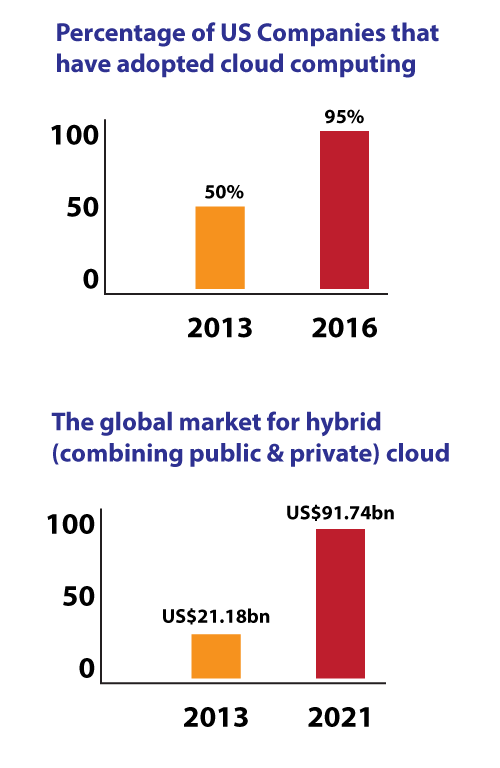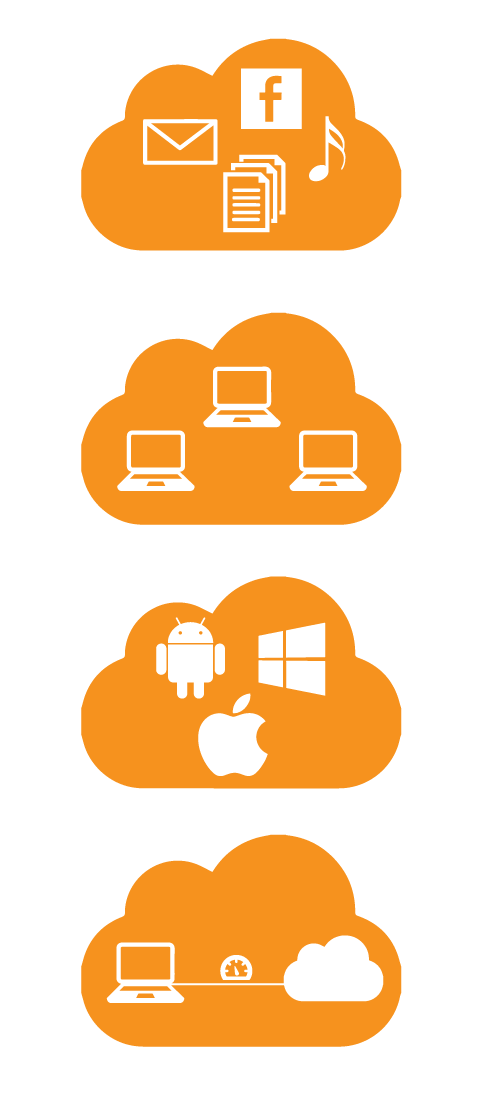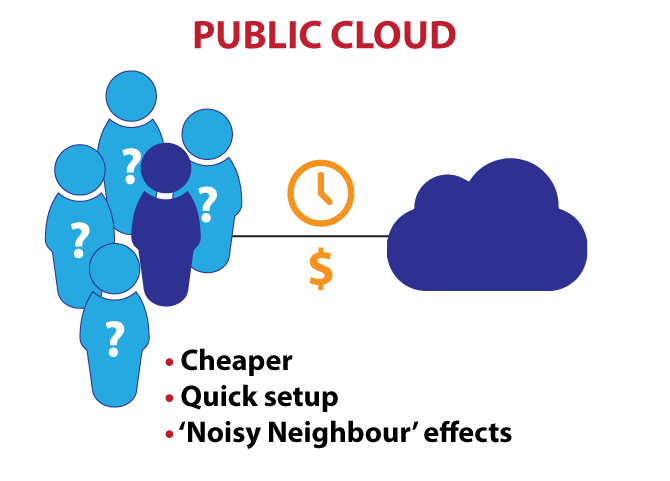-
If you've ever used Gmail, Facebook or Dropbox, congratulations: you're a cloud computing user.
The ‘cloud’ has moved well beyond its industry buzzword beginnings and is now the operating standard for the online world, with even the smallest companies benefitting from it.
" If you've ever used Gmail, Facebook or Dropbox, you're already a cloud computing user."
Drew Turney, Freelance journalistBut there's still a lot to decipher, a lot of hype - a lot of the 'benefits' you hear are no more than sales pitches. You might also feel silly about asking what all the terms mean in an industry that's so mature, so here's our handy reckoner on the basics.
TYPES OF CLOUD SERVICES
• Software as a Service (SaaS)
The most popular product class of cloud computing, SaaS is simply an application you'd normally run on your computer hosted online, often on a per-period basis rather than one out of the box price.
Common examples are everyday accounting products like Xero or Quickbooks or email like Gmail or Hotmail.
• Platform as a Service (PaaS)
Usually used by software developers, PaaS lets you buy time or disk space on a virtual operating system to design, program and test applications before investing in computers of your own to run or host them.
• Infrastructure as a Service (IaaS)
As the name suggests, your IT infrastructure is virtual, hosted elsewhere and accessed just like the computers were under your own roof.
If a company has a fluctuating workforce it might hire virtual copies of PCs, the system hosting and deploying multiple user desktop environments and then shutting them down when not needed.
• Network as a Service (NaaS)
Sometimes you might use a lot of network bandwidth, sometimes less so. Rather than pay for expensive high bandwidth data pipes between you and the outside world, NaaS lets you pay on an as-needed basis just like other cloud services let you buy storage, environments or platforms when you need them.
A good example is digital effects companies for movies and TV who have to send huge video files back and forth only while they're involved in a project.

Most cloud products suit enterprise or large organisational users.
Providers like Google, Amazon and Microsoft are at the forefront of the industry but almost all the big names from the tech sphere have gotten in on the act, many of them abandoning traditional markets in hardware to do so.
PRIVACY SETTINGS
You might also have heard of a private cloud. Essentially an update of the old methodology of the mainframe, it involves setting up a cloud service like the ones above on computer equipment only you have access to use, whether on your own premises or in a data centre.
An example might be where you have too much sensitive data to store with a public provider like Amazon Web Services, like an accountant with clients' financial records.
Both public and private clouds have their pros and cons. The public cloud is a popular choice for starting out as there's no outlay for buying or renting new hardware and you don't have to pay for any more data or disk space than you use. When the project's over, you can just switch it off and not be stuck with a pile of obsolete computer equipment.
Public cloud services can take mere hours to set up and deploy. One of the biggest selling points is their ability to handle overflow or 'bursty' workloads, like a jump in ecommerce activity because of gift seasons or the sending of a software update to a large workforce of users.
{CF_IMAGE}
So when is a private cloud better? Providers can assure you a seamless service but the fact is you never know who you're being hosted with.
Your data might compete for input/output resources with other processes, encountering what's called the 'noisy neighbour' effect when other tenants' unpredictable usage affects your performance.
{CF_IMAGE}
THE NEW MOBILITY
Many organisations pick the best of public and private clouds and build systems using both. Also called hybrid, a common methodology is to 'buy the base, rent the peak'.
You can use equipment you already have to crunch critical or regular-load data and if you have periods of high or uneven activity, directing it to the pay-as-you-use model of a public cloud is inexpensive and easy.

Of the three cloud models (public, private and cloud), hybrid is enjoying the most growth. According to technology research and advisory firm RNR Market Research, hybrid
was worth $US21.18 billion in 2013 and will balloon to $US91.74 billion by 2021, growing at 22.5 percent annually, with the highest rate of growth coming from the Asia Pacific.
CLOUD BY NUMBERS
The cloud is already a mature industry populated by reputable names. Forbes Magazine reported half of all US companies used cloud computing back in April 2013. Today, according to the 2016 State of the
Cloud Survey by cloud service provider RightScale, the figure is 95 per cent.
According to US mobile phone carrier Verizon's annual enterprise cloud report, spending on cloud computing has increased 38 percent year on year. 68 percent of companies surveyed in the report said they had no choice but to invest in cloud (particularly SaaS) to achieve their goals – for many, cloud computing is no longer a matter of choice.
Closer to home, research by cloud provider Rackspace among Australian senior IT leaders found 54 per cent of companies surveyed had migrated processes into the cloud and 46 per cent intended to, perhaps proving there are pockets of high adoption across certain sectors. Insight and advisory service Telsyte reports spending in enterprise level cloud services is set to approach $800m in Australia by 2019.
But cloud computing is also replete not just a lot of hype but a lot of false positives. The RightScale survey was focused on Infrastructure as a Service (IaaS) and because many of RightScale's customers and potential customers are cloud users, such results will naturally affect the company's view.
After all the hyperbole about the cloud bandwagon, the 2013-14 Business Characteristics Survey by the Australian Bureau of Statistics (the most recent data) reported only one in five Australian companies was using a paid cloud computing service.
IS THE CLOUD FOR YOU?
Ask your IT department (engage an impartial cloud services consultant or broker if you don't have one) to conduct a thorough audit of the data you have to work with and the applications you need to run. In each case, figure out if there's a cloud equivalent and do your sums thoroughly. The questions to ask your self are almost endless. Just some are;
• Are there any restraints or regulations you need to adhere to, for example if you host customers' credit card numbers?
• Are there uneven or unpredictable spikes in activity?
• How damaging will it be if your systems go offline for an hour, a day or a week – to your brand as well as your bottom line?
• Can you current systems handle anticipated growth in operations?
There'll be a cost involved in moving to the cloud – in money, manpower and training – but it might save you hardware or bandwidth costs in the long run. Only then will you really be ahead of the curve rather than just going along with the trend.
Drew Turney is a freelance journalist
The views and opinions expressed in this communication are those of the author and may not necessarily state or reflect those of ANZ.
-
-
anzcomau:Bluenotes/technology-innovation,anzcomau:Bluenotes/technology-innovation/disruption,anzcomau:Bluenotes/technology-innovation/digital
Demystifying cloud computing
2016-10-14
/content/dam/anzcomau/bluenotes/images/articles/2016/October/truneycloud_banner.png
EDITOR'S PICKS
-
-
Often we are told, to understand something we need to experience it for ourselves. This applies to most things in life, including business but I would argue it certainly does not apply to cybercrime and fraud. In these scenarios it is much better to learn from the experiences of others.
12 October 2016 -
In Australia last week, the banking industry was focussed on a parliamentary inquiry into the industry’s culture and response to a range of issues from customer complaints to pricing to market behaviour.
12 October 2016


